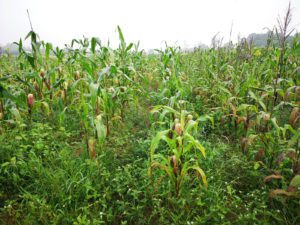False codling moth (Thaumatotibia leucotreta) is a Lepidopteran belonging to the family Tortricidae, which poses a great challenge to majorly the citrus industry.
The moths are inactive during the day and active during some portions of the night.
Also known as citrus codling moth or orange moth,
Host Range
- Citrus hosts, e.g. oranges, lemons,
- Non citrus hosts, e.g. guava, plums, beans, peaches
Life Cycle
The female moth lays eggs mostly between 5.00pm and 11.00pm. The eggs are deposited on the surface of the host fruit .They can also be oviposited on leaves, fallen fruit, and on smooth-surfaced tissue. Egg incubation is temperature dependent and the period from deposition to hatching ranges from 2 to 22 days. The hatched larvae feed and live for 12- 65 days depending on weather conditions. Upon maturity, they exit the fruit and drop to the ground on silken threads. The pupal stage is both temperature and gender regulated, i.e., warmer conditions are conducive to a quick emergence, males mature within 13-48 days while females take 11-40 days.
A single female moth can produce up to 800eggs under favourable conditions.
The males live between 14 and 58days, whereas females live between 16 and 80 days.
2-10 generations are possible in a year.
Identification
- Eggs– they are about 1mm, flat, oval and translucent white. Their body surfaces are shiny with a pattern on them. They gain reddish colour as development continues.
- Larvae– these are 1-20 mm, with creamy white and brownish-black heads initially, which have minute black spots and hair-like structures. As they mature, they develop light overall pink color with orange-yellow color on the sides, top, and legs, while the heads become light maroon.
- Pupae– they are cylindrical and about 7mm, cream-colored and soft initially. However, they turn yellow to dark brown as they harden. The cocoons may contain leaf fragments or soil
- Adults– they are grayish-brown to dark brown or black in colour and about 6-9 mm long and 2.5 mm wide. Their forewings have a black triangular patch while the hind wings are lighter grayish-brown and darker on the outer edges. They have a wingspan of 16 – 20 mm. The front wings also have a fringe of hairs and their antennae are thin and multi-segmented with tiny hairs on each segment.
Feeding & Damage
Once hatched from the eggs the larvae burrow into the rind of the fruit. A discoloration appears at the point of entrance. While inside they feed on the pulp, causing premature ripening and fruit drop.
Young larvae feed on the outer portion while older ones move further into the interior of the fruit.
The open cavity is a point of entry for other pests and pathogens.
Larvae prefer the navel end of citrus but can burrow anywhere on the fruit leaving excrement around the openings.
Only a few larvae can survive per fruit.
Management & Control
Chemical Control
The moth develops resistance so fast and therefore there is need to counter this through alternation of several chemicals.
The following insecticides are effective in controlling false coddling moth.
- LEXUS 247SC 8ml/20l
- KINGCODE ELITE 50EC 10ml/20l
- PRESENTO 200SP 5ml/20l
- PROFILE 440EC 30ml/20l
- SINOPHATE 750SP 20g/20l
- ESCORT 19EC 10ml/20l
- LEGACY 50EC 15ml/20l
- PENTAGON 50EC 10ml/20l
- TRUMPET 200SC 20ml/20l
Biological Control
- BACIGUARD 16WDG 15g/20l is a biological insecticide which acts by multiplying bacteria strain of Bacillus thuringiensis (Bt) on the false coddling moth’s body thus eliminating it.
NOTE;
- When spraying any insecticide, it is advisable to mix it with INTEGRA 3ml/20l. This is a sticker, spreader and penetrant which improves the efficacy of the product.
- Timely application of the insecticide is very critical for effective control of the moth.
Other control practices
They include the following;
- Maintenance of field hygiene
- Planting resistant varieties
- Proper weed control
- Crop rotation






